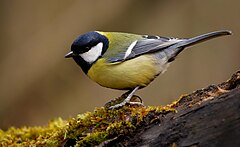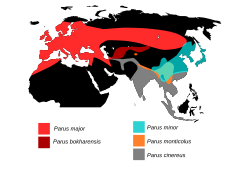Parus
Wygląd
| Parus | |||
| Linnaeus, 1758[1] | |||
 Przedstawiciel rodzaju – bogatka zwyczajna (P. major) | |||
| Systematyka | |||
| Domena | |||
|---|---|---|---|
| Królestwo | |||
| Typ | |||
| Podtyp | |||
| Gromada | |||
| Podgromada | |||
| Infragromada | |||
| Rząd | |||
| Podrząd | |||
| Rodzina | |||
| Rodzaj |
Parus | ||
| Typ nomenklatoryczny | |||
|
Parus major Linnaeus, 1758 | |||
| Synonimy | |||
| |||
| Gatunki | |||
| |||
| Zasięg występowania | |||

| |||
Parus – rodzaj ptaków z rodziny sikor (Paridae).
Zasięg występowania
[edytuj | edytuj kod]Rodzaj obejmuje gatunki występujące w Eurazji i północnej Afryce[4].
Morfologia
[edytuj | edytuj kod]Długość ciała 12,5–15 cm; masa ciała 11,9–22,1 g[5].
Systematyka
[edytuj | edytuj kod]Rodzaj zdefiniował w 1758 roku szwedzki przyrodnik Karol Linneusz w 10. edycji publikacji swojego autorstwa o tytule Systema Naturae[1], uznawanej za początek nomenklatury zoologicznej. Linneusz nie wskazał gatunku typowego. W ramach późniejszego oznaczenia w 1840 roku brytyjski ornitolog George Robert Gray na typ nomenklatoryczny wyznaczył bogatkę zwyczajną (P. major)[6].
Etymologia
[edytuj | edytuj kod]- Parus (Patus): łac. parus „sikora” (por. par, parum „równy, towarzysz”)[7].
- Parulus: rodzaj Parus Linnaeus, 1758 (sikora); łac. przyrostek zdrabniający -ulus[8].
Podział systematyczny
[edytuj | edytuj kod]Do rodzaju należą następujące gatunki[9]:
- Parus monticolus Vigors, 1831 – sikora zielonogrzbieta
- Parus major Linnaeus, 1758 – bogatka zwyczajna
- Parus cinereus Vieillot, 1818 – bogatka orientalna
Uwagi
[edytuj | edytuj kod]Przypisy
[edytuj | edytuj kod]- ↑ a b C. Linnaeus: Systema naturae per regna tria naturae: secundum classes, ordines, genera, species, cum characteribus, differentiis, synonymis, locis. Wyd. 10. T. 1. Holmiae: Impensis Direct. Laurentii Salvii, 1758, s. 189. (łac.).
- ↑ P.L.S. Müller: Des Ritters Carl von Linné Königlich Schwedischen Leibarztes &c. &c. Vollständiges Natursystem: Supplements- und Register-Band über alle sechs Theile oder Classen des Thierreichs. Mit einer ausführlichen Erklärung. Nürnberg: Gabriel Nicolaus Raspe, 1776, s. 178. (niem.).
- ↑ C.S. Rafinesque: Analyse de la nature, or, Tableau de l’univers et des corps organisés. Palerme: Aux dépens de l’auteur, 1815, s. 219. (fr.).
- ↑ F. Gill, D. Donsker & P. Rasmussen (redaktorzy), Waxwings and allies, tits, penduline tits [online], IOC World Bird List (v13.1) [dostęp 2023-07-09] (ang.).
- ↑ D.W. Winkler, S.M. Billerman & I.J. Lovette, Tits, Chickadees, and Titmice (Paridae), version 1.0, [w:] S.M. Billerman, B.K. Keeney, P.G. Rodewald & T.S. Schulenberg (redaktorzy), Birds of the World, Cornell Lab of Ornithology, Ithaca, NY 2021, Parus, DOI: 10.2173/bow.parida1.01 [dostęp 2023-07-09] (ang.).

- ↑ G.R. Gray: A list of the genera of birds: with their synonyma an indication of the typical species of each genus. Wyd. 2. London: R. and J.E. Taylor, 1841, s. 23. (ang.).
- ↑ The Key to Scientific Names ↓, Parus [dostęp 2022-01-15].
- ↑ The Key to Scientific Names ↓, Parulus [dostęp 2023-07-09].
- ↑ Systematyka i nazwy polskie za: P. Mielczarek & M. Kuziemko, Rodzina: Paridae Vigors, 1825 - sikory - Tits, chickadees (wersja: 2020-07-21), [w:] Kompletna lista ptaków świata [online], Instytut Nauk o Środowisku Uniwersytetu Jagiellońskiego [dostęp 2023-07-09].
Bibliografia
[edytuj | edytuj kod]- The Key to Scientific Names, J.A. Jobling (red.), [w:] Birds of the World, S.M. Billerman et al. (red.), Cornell Lab of Ornithology, Ithaca (ang.).
Identyfikatory zewnętrzne:
